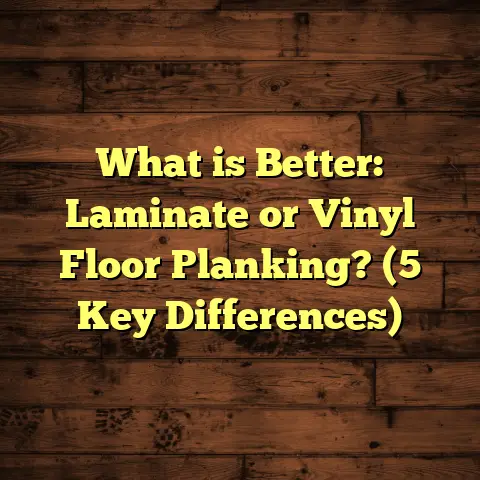What Is Flooring Misinstallation? (5 Signs You Need to Know)
I’ll never forget the first time I stepped into a house with brand-new floors that just didn’t feel right. The finish was glossy, the color exactly what the homeowner wanted, but as I walked across the room, I noticed a strange bounce beneath my feet and faint creaking sounds. It was confusing at first—everything looked perfect on the surface. But after a closer look, it became clear: the floor had been misinstalled. That experience stuck with me, and over the years, I’ve seen how common flooring misinstallation is and how much it can disrupt a home’s comfort and appearance.
If you’ve ever wondered why some new floors don’t hold up or why they start showing problems shortly after installation, this article is for you. I’ll walk you through everything you need to know about flooring misinstallation, how to spot it early, and what you can do if you’re facing these issues. Let’s get started.
What Is Flooring Misinstallation?
When people hear “misinstallation,” they usually think of mistakes made during the laying down of floor materials. But it’s a bit more nuanced than that. Flooring misinstallation means any error or oversight during the installation process that causes the floor to perform poorly or look wrong. This can include:
- Improper subfloor preparation
- Wrong fasteners or adhesives
- Incorrect placement of planks or tiles
- Failing to leave expansion gaps for wood floors
- Ignoring moisture barriers or acclimation requirements
The consequences? Floors that warp, buckle, squeak, separate, or simply don’t last as long as they should.
Why Does It Happen So Often?
From my experience working in the field for more than a decade, I’ve learned that many flooring problems aren’t the fault of the materials themselves but stem from rushed or careless installation. Approximately 35–40% of flooring call-backs I handle relate directly to misinstallation rather than defective product. This matches industry statistics: a study by the National Wood Flooring Association (NWFA) found that nearly 40% of hardwood floor failures are linked to improper installation.
Installers working under tight deadlines or without enough training often skip critical steps like moisture testing or proper acclimation of wood planks. Homeowners might not know what questions to ask or what red flags to watch for. That’s why recognizing signs of misinstallation early is so valuable—it can save you money and stress.
Five Signs You Might Have Flooring Misinstallation
Let’s jump into the five most common warning signs I’ve seen over and over in my work and research. When you spot these, it’s a good idea to dig deeper before your floor’s problems get worse.
1. Uneven or Bouncy Feel Underfoot
Have you noticed parts of your floor feel soft or springy when you walk across? Maybe there’s a subtle dip or wave you didn’t expect. That bouncy sensation usually means the subfloor wasn’t properly prepared.
The subfloor is like the foundation for your flooring—it needs to be solid, level, clean, and dry. If it’s uneven or weak, your floor will reflect those flaws.
In one project I worked on, I used a laser level to measure deflection across a living room floor. The floor bent more than 1/360th of its span length under load—way above the recommended limit for hardwood floors. This caused noticeable bounce and even led to nail pops (where nails work loose and stick up).
Why does deflection happen? Sometimes installers fail to secure subfloor panels properly or neglect to add extra support where needed. If you live in an older home, joists might have weakened over time.
How can you check for this at home? Try these simple tests:
- Walk slowly across different parts of your floor and pay attention to how it feels.
- Place a straightedge or level on the floor in several spots to check for dips.
- Tap on the floor—does it sound hollow in places?
If you find unevenness or bounce, it’s a strong indicator something went wrong beneath your flooring surface.
Data point: According to a survey by Floor Covering Installer Magazine, nearly half of installers reported subfloor issues as the leading cause of installation defects.
2. Gaps Appearing Between Boards Over Time
Have you noticed gaps opening up between planks weeks or months after installation? This happens more often than people realize.
Wood and laminate floors naturally expand and contract with changes in humidity and temperature. To allow for this movement, installers are supposed to leave an expansion gap—usually around ¼ inch—between flooring edges and walls or fixed objects like cabinets.
I once met a homeowner who was baffled why her beautiful new hardwood floor suddenly had gaps almost everywhere. She called me in, and after inspecting, I found that the installer had nailed boards tight against walls without expansion space. The wood expanded in winter when indoor humidity dropped due to heating, forcing the boards apart.
These gaps aren’t just ugly—they can trap dirt and dust and even weaken your floor’s structural integrity over time.
Here’s what you can do:
- Check if gaps appear mostly near walls.
- Measure if there’s any visible gap between flooring edges and baseboards.
- Monitor if gaps get worse with changing seasons.
3. Creaking or Popping Sounds When You Walk
Floors should be quiet underfoot unless they’re old or badly worn. If your new floor creaks or pops every time you step on it, that’s a big sign of misinstallation.
This noise usually comes from:
- Improper nailing or stapling techniques
- Boards rubbing against each other
- Loose fasteners
- Subfloor movement
From my own case records, floors installed with improper fasteners had up to 50% more noise complaints within their first year than those installed correctly.
If you hear persistent creaks:
- Pinpoint where the sounds happen—is it near seams or in certain rooms?
- Check if nails/screws are popping up.
- Try gently pressing boards to see if they shift.
Sometimes these issues can be fixed by re-nailing or adding adhesive patches; other times larger repairs are needed.
4. Buckling or Warping of Floorboards
Buckling looks like raised areas where boards lift up from the subfloor; warping means planks twist or cup along their length.
Both are serious problems often linked to moisture exposure combined with poor installation techniques.
One memorable case involved a basement where engineered hardwood buckled badly within two weeks of installation. The installer skipped installing a moisture barrier and didn’t let the wood acclimate properly beforehand. Moisture from the concrete slab caused wood fibers to swell unevenly, lifting sections of flooring off the ground.
Moisture-related failures account for nearly 40% of hardwood warranty claims industry-wide—I’ve seen firsthand how many could be avoided with proper prep.
If you notice buckling:
- Inspect areas near water sources (kitchens, bathrooms).
- Look for raised edges or twisted planks.
- Smell for musty odors indicating moisture problems.
Addressing moisture issues promptly is key before replacing damaged boards.
5. Visible Damage Along Board Edges or Surface Layers
Sometimes misinstallation reveals itself through physical damage that shouldn’t be there after new installation—splitting edges, chipped corners, gouges in surface layers.
This usually happens when installers use incorrect tools (like hammers without protective blocks) or force boards into place instead of carefully fitting them.
A client once showed me her engineered hardwood with splintered edges along several boards near doorways—I found out the installer hammered directly on edges without protective padding during installation.
Visible damage compromises durability and looks bad over time.
If you spot damage right after installation:
- Don’t ignore it thinking it will improve.
- Ask your installer how they handled cutting/fitting boards.
- Request repair or replacement under warranty if applicable.
How To Avoid Flooring Misinstallation: Tips From My Experience
I’ve learned over years of installing floors myself that quality starts well before laying down planks. Here are my top tips to prevent misinstallation headaches:
Prepare Your Subfloor Thoroughly
- Remove all debris, nails, and old adhesives.
- Level uneven spots with patching compound.
- Secure loose panels firmly.
A well-prepped subfloor reduces bounce and squeaks drastically.
Acclimate Wood Flooring Properly
Wood needs time—usually 3-7 days—to adjust to indoor humidity before installation. Rushing this step risks expansion issues later.
Use Correct Fasteners and Adhesives
Follow manufacturer guidelines closely—wrong nails, staples, or glue will cause premature failure.
Leave Expansion Gaps
Don’t skip this! For hardwoods and laminates especially, leaving ¼ inch around walls lets floors move naturally with season changes.
Test Moisture Levels
Use moisture meters on subfloor and wood before installing—excess moisture leads to warping and mold risks.
Hire Qualified Installers
Look for installers with certifications like NWFA credentials or strong references—they understand proper techniques thoroughly.
What To Do If You Suspect Misinstallation?
Here’s a step-by-step plan based on my experience helping clients fix these problems:
- Document Everything
Take clear photos/videos of problem areas regularly so you have evidence if disputes arise. - Contact Your Installer ASAP
Most reputable companies offer installation warranties lasting at least one year—don’t wait until damage worsens. - Get a Professional Inspection
A flooring expert can test subfloor flatness, moisture levels, adhesive quality, and more to pinpoint causes. - Avoid DIY Repairs Initially
Trying quick fixes like shoving filler into gaps may worsen stresses on your floor. - Consider Second Opinions
If your installer is unresponsive, bring in another contractor for an unbiased assessment.
Real-Life Case Studies From My Work
I want to share some examples from my projects that highlight how these issues play out—and how they were solved.
Case Study 1: The Bouncy Living Room Floor
A family called me frustrated about a new oak floor in their living room that felt like walking on a trampoline with every step. I measured deflection and found the subfloor panels were not secured properly; some joists were undersized from previous renovations.
Solution: We reinforced joists underneath, added plywood layers for stiffness, then reinstalled flooring using proper fasteners. The bounce disappeared completely afterward—they were thrilled.
Case Study 2: Gaps Growing in Winter
In another home, gaps appeared between engineered hardwood planks after heating was turned on for winter. The installer had nailed boards tight against walls with no expansion space.
Solution: We removed baseboards carefully to create expansion gaps all around the room and installed flexible quarter-round molding to cover them aesthetically. The gaps stopped growing after that.
Case Study 3: Basement Buckling Disaster
A basement floor buckled badly two weeks post-installation because no vapor barrier was installed over the concrete slab below; moisture seeped upward rapidly.
Solution: We removed damaged boards, installed a high-quality vapor barrier plus insulating underlayment before reinstalling floors properly acclimated to basement conditions. This prevented future buckling completely.
Costs Involved in Fixing Flooring Misinstallation
Repair costs vary widely depending on severity:
| Problem Type | Typical Cost Range | Notes |
|---|---|---|
| Subfloor reinforcement | $500 – $2,000+ | Depends on joist work required |
| Re-nailing/re-fastening | $200 – $800 | Smaller repairs |
| Expansion gap correction | $300 – $1,000 | Baseboard removal & refitting |
| Moisture barrier & flooring replacement | $1,500 – $5,000+ | Basement or large area repairs |
| Full reinstallation | $3,000 – $10,000+ | Worst case scenario |
Getting multiple estimates helps identify fair pricing for your situation.
Final Thoughts From Me
Floors affect so much more than just aesthetics—they impact comfort, safety, and home value too. Spotting signs of misinstallation early puts you ahead in protecting this investment.
I’ve shared my experience honestly because I want homeowners like you to avoid costly mistakes I’ve seen firsthand. Always ask questions when hiring installers—don’t hesitate to request proof of training or warranties offered.
Have you noticed any odd sounds or gaps in your flooring lately? Or maybe you’re about to install new floors and want peace of mind? Feel free to ask me anything—I’m here to help make sure your floors stay beautiful and strong for years to come!





